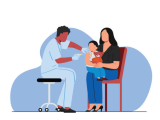See related article posted today: "Experts stress vigilance over emerging, unpredictable diseases"
Oct 29, 2008 (CIDRAP News) – Saying Americans are threatened by a rising tide of emerging and resurging infectious diseases, the nonprofit group Trust for America's Health (TFAH) today issued a report calling on the US government to launch a comprehensive campaign to battle the microbes at home and abroad.
"Americans are more vulnerable than we think we are, and our defenses are not as strong as they should be," TFAH Executive Director Jeffrey Levi, PhD, said at a news briefing on the 44-page report, "Germs Go Global: Why Emerging infectious Diseases Are a Threat to America."
"Infectious diseases are not just a crisis for the developing world. They are a real threat right here, right now to America's economy, security, and health systems," Levi commented in a news release.
Quoting an estimate from the National Intelligence Council in 2000, the report says emerging and re-emerging infectious diseases "will continue to kill at least 170,000 Americans annually" and "will complicate US and global security over the next 20 years."
TFAH, based in Washington, DC, said the nation should take an array of steps to combat infectious diseases, such as building up public health capacity and improving disease surveillance both nationally and globally and adopting strategies to develop new vaccines, antimicrobials, and diagnostic tests. The group called on congress to take specific steps toward those ends, such as fully funding the Biomedical Advanced Research and Development Agency (BARDA).
A disease smorgasbord
In the report and news release, TFAH cites a wide range of new and older diseases that threaten or may threaten the nation, including HIV/AIDS, severe acute respiratory syndrome (SARS), H5N1 avian influenza and its potential for sparking a pandemic, tuberculosis (TB), hepatitis C, Lyme disease, Legionnaire's disease, and dengue fever.
"We also have the diseases of old that continually threaten us," said Kathleen Gensheimer, MD, MPH, Maine's state epidemiologist, speaking at the press conference. "In Maine we worked up a large outbreak of mumps this past winter, over 100 cases," which necessitated costly control measures. Gensheimer served on a peer review board for the report.
More than 130 cases of measles—once thought to be largely eliminated because of immunization—have been reported in the United States this year, the most since 2001, the report notes. In addition, the nation continues to face a risk of terrorist attempts to spread diseases such as anthrax, botulism, plague, and smallpox, it says.
Another danger is methicillin-resistant Staphylococcus aureus (MRSA), which causes serious skin, soft-tissue, and bloodstream infections. Once confined mainly to healthcare settings, MRSA infections are increasingly occurring in the community, the report notes.
The report cites 13 factors spurring the emergency of infectious diseases. The leading ones include antimicrobial resistance; globalization; climate change, which leads to the spread of disease-carrying insects; poverty and the associated lack of healthcare and poor sanitation; war and civil strife; and high-risk behaviors.
"The trends involving most of these factors are in a direction favoring the microbes," said James Hughes, MD, an Emory University professor of public health who formerly headed the infectious disease branch at the Centers for Disease Control and Prevention (CDC). Hughes, a peer reviewer of the TFAH report, spoke at the news conference.
Chinks in the armor
Despite these threats, the private research and development pipeline for countermeasures against most emerging diseases is "stagnant or nonexistent," the report asserts. Reasons include a common view that these diseases are confined to the developing world and that vaccines and drugs for them are not profitable for US drug companies.
Since 1998, only 12 new antibiotics have been approved in the United States, and only two of those had a truly new mechanism of action, the report says. And despite some progress on vaccines, there are still no highly effective vaccines against three of the biggest killers: HIV/AIDS, TB, and malaria.
Disease surveillance capabilities also fall short, according to TFAH. The United States has a number of surveillance networks, but overall the nation lacks a "robust, coordinated capability." Internationally, there are programs that monitor particular diseases, but the support for tracking emerging diseases is "relatively weak," the report states.
Also needed are better diagnostic tests—especially "point of care" tests. Exhibit A is TB, for which the standard test in most of the world is more than 50 years old and only 50% accurate.
A Manhattan Project?
The TFAH report argues that a decidedly major effort is needed to remedy the situation: "The US government should lead efforts to detect and conquer emerging infectious diseases with the same energy it devoted to tackling polio in this country during the last century."
Gensheimer likened the scale of effort needed to that in the Manhattan Project, which developed the first nuclear bombs during World War II.
The report offers a lengthy set of recommendations for the nation, which largely mirror those made by the Institute of Medicine in its 2003 report "Microbial Threats to Health." Here are the key ones:
- Governments at all levels should provide the resources to build the ublic health capacity to respond to infectious diseases. In particular, the CDC should lead an effort to provide the nation with a disease surveillance system that is interoperable among jurisdictions and agencies.
- The nation should step up its leadership in enhancing global capacity to respond to infectious disease threats.
- The federal government should take the lead in "promoting the implementation of a comprehensive system of surveillance for global infectious diseases."
- The government should lead the development of a comprehensive, long-term research agenda, including strategies for vaccines, antimicrobials, antibiotic resistance, diagnostics, surveillance, and insect vector control.
- The government and all components of the health system should expand efforts to reduce the inappropriate use of antimicrobials.
- The government should work with academia and private groups to recruit, retain, and train public health professionals to combat emerging infectious diseases.
- Public health education efforts aimed at stopping infectious diseases should be stepped up. Efforts should focus on hand hygiene, cough etiquette, and following vaccination recommendations.
TFAH also appeals to Congress to take specific steps related to the above. For example, Congress is urged to:
- Fully fund BARDA. Congress authorized $1.07 billion for the program for 2006 through 2008, but actually provided only $102.1 million for fiscal year 2008.
- Pass the proposed Strategies to Address Antimicrobial Resistance (STAAR) Act.
- Restore funds for the CDC's programs to support state and local public health preparedness at least to the fiscal year 2005 level of $919 million, versus the $746 million provided this year.
In response to a question about the chances of increasing funding for public health in the current financial crisis, Levi commented, "Even in this difficult financial climate we're going to see federal investments in infrastructure, roads, alternative energy sources. Making sure in difficult financial times that people are protected from disease also has to be a priority. The level we're talking about is not huge compared to what's being proposed to invest in other areas."
Gensheimer added that every dollar spent on vaccines is estimated to save $27 in overall healthcare costs, and that only 4% of US health spending is for prevention.
See also:
Oct 29 TFAH news release
http://healthyamericans.org/newsroom/releases/?releaseid=146
Full text of report
http://healthyamericans.org/assets/files/GermsGoGlobal.pdf


















